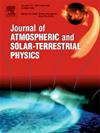Automatic detection and classification of Spread-F in ionograms using convolutional neural network
IF 1.9
4区 地球科学
Q3 GEOCHEMISTRY & GEOPHYSICS
Journal of Atmospheric and Solar-Terrestrial Physics
Pub Date : 2025-03-28
DOI:10.1016/j.jastp.2025.106504
引用次数: 0
Abstract
Equatorial spread-F (ESF) is an irregularity caused by plasma instabilities on the night side that causes signal degradation and disruptions to the GNSS signals. Ionosondes could detect ESF as it appears as a diffused echo in the ionogram images. This study proposes a Convolutional Neural Network (CNN) model that can automatically detect ESF within the ionogram images and classify its type. The model has been trained using 2646 manually labeled ionograms from the Low Latitude Ionospheric Sensor Network (LISN) VIPIR Ionosondes in South America. The data used to train the model was measured from 2019 to 2024. The model was able to classify the testing images into six categories: Clear class, frequency spread-F (FSF), range spread-F (RSF), mixed spread-F (MSF), strong spread-F (SSF), and Unidentified class. It demonstrated high classification accuracy within the extracted test subset and a further random test, showcasing robustness and consistency in detection accuracy across all classes. Furthermore, the model performance has been evaluated and compared with other baseline models: VGG16, VGG19, ResNet18, and Inception-V3 in the same environment. Additionally, a comparison with published models is provided. Our model showed a higher consistency in classification accuracy across all classes compared to the mentioned models.
利用卷积神经网络对离子图中的 Spread-F 进行自动检测和分类
赤道扩散f (ESF)是由等离子体在夜侧不稳定引起的一种不规则现象,它会导致信号退化和GNSS信号中断。离子探空仪可以探测到ESF,因为它在离子图图像中表现为扩散回声。本文提出了一种卷积神经网络(CNN)模型,该模型可以自动检测离子图图像中的ESF并对其类型进行分类。该模型使用来自南美洲低纬度电离层传感器网络(LISN) VIPIR电离层探空仪的2646个人工标记电离层图进行训练。用于训练模型的数据是从2019年到2024年测量的。该模型能够将测试图像分为六类:清晰类、频率扩散f (FSF)、距离扩散f (RSF)、混合扩散f (MSF)、强扩散f (SSF)和未识别类。它在提取的测试子集和进一步的随机测试中证明了较高的分类准确性,展示了所有类的检测准确性的鲁棒性和一致性。此外,在相同的环境下,对该模型的性能进行了评估,并与其他基线模型:VGG16、VGG19、ResNet18和Inception-V3进行了比较。此外,还提供了与已发布模型的比较。与上述模型相比,我们的模型在所有类别的分类精度上显示出更高的一致性。
本文章由计算机程序翻译,如有差异,请以英文原文为准。
求助全文
约1分钟内获得全文
求助全文
来源期刊

Journal of Atmospheric and Solar-Terrestrial Physics
地学-地球化学与地球物理
CiteScore
4.10
自引率
5.30%
发文量
95
审稿时长
6 months
期刊介绍:
The Journal of Atmospheric and Solar-Terrestrial Physics (JASTP) is an international journal concerned with the inter-disciplinary science of the Earth''s atmospheric and space environment, especially the highly varied and highly variable physical phenomena that occur in this natural laboratory and the processes that couple them.
The journal covers the physical processes operating in the troposphere, stratosphere, mesosphere, thermosphere, ionosphere, magnetosphere, the Sun, interplanetary medium, and heliosphere. Phenomena occurring in other "spheres", solar influences on climate, and supporting laboratory measurements are also considered. The journal deals especially with the coupling between the different regions.
Solar flares, coronal mass ejections, and other energetic events on the Sun create interesting and important perturbations in the near-Earth space environment. The physics of such "space weather" is central to the Journal of Atmospheric and Solar-Terrestrial Physics and the journal welcomes papers that lead in the direction of a predictive understanding of the coupled system. Regarding the upper atmosphere, the subjects of aeronomy, geomagnetism and geoelectricity, auroral phenomena, radio wave propagation, and plasma instabilities, are examples within the broad field of solar-terrestrial physics which emphasise the energy exchange between the solar wind, the magnetospheric and ionospheric plasmas, and the neutral gas. In the lower atmosphere, topics covered range from mesoscale to global scale dynamics, to atmospheric electricity, lightning and its effects, and to anthropogenic changes.
 求助内容:
求助内容: 应助结果提醒方式:
应助结果提醒方式:


